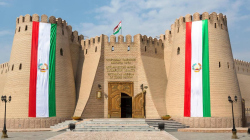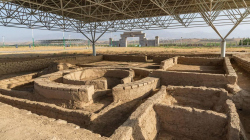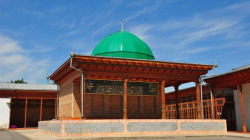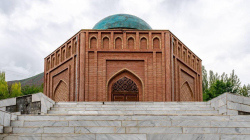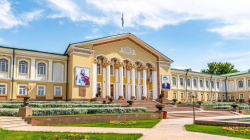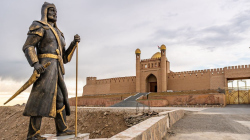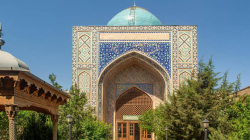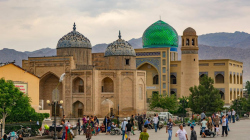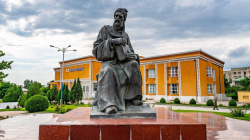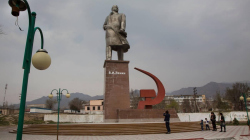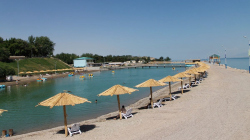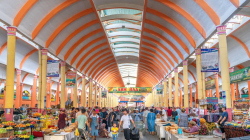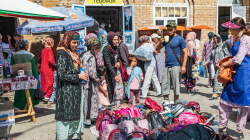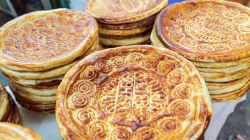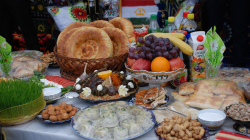Day 1: Panjakent City – Ancient Sarazm – Rudaki Mausoleum
08:00 Welcome tourists from the hotel in territory of Dushanbe, departure to Khujand, driving through the Hissor and Fann mountains range.
10:00 the same time it is thinkable to receive tourists from the Panjakent/Samarqand border.
Arriving Panjakent and have a lunch to a local restaurant. Later, starting the sightseeing Panjakent - Sughd region hub, nestled in the Zarafshan River valley, offers rich historical monuments and scenic riverbanks:
- Sarazm, Tajikistan's inaugural World Heritage Monument, dates back to the IV-II millennium BC. Situated 15 km west of Penjikent, it holds well-preserved relics, including palaces, religious, public, and residential structures. Rich in historical significance, Sarazm is part of the Bactrian-Margian Archaeological Complex, its name derived from the ancient Tajik term "sari zamin" (beginning of the earth).
- Rudaki Mausoleum, a revered site in Panjrud, Tajikistan, commemorates Rudaki (858-941), the literary pioneer of Tajik-Persian literature. A symbol of cultural richness, the mausoleum stands adorned with Persian-style architecture, featuring a dome and a marble sarcophagus. Abu Abdullah Jafar Rudaki, the "Father of Persian poetry," rests here.
Then continue our trip, departure to Istaravshan.
Arriving Istaravshan, accommodation to hotel and dinner in the national restaurant.
Day 2: Istaravshan
City Tour – Kok-Gumbaz – Handicraft Street
Enjoy breakfast
at the hotel.
Welcome tourists
from the hotel, commence the city tour of Istaravshan - a city at 1178 meters, boasts
a rich history, dating back 2500 years. An ancient trade hub, it's Central Asia's
cultural gem, flourishing during Alexander the Great's era. Explore historical sites
including:
- Hazrati Shoh
Mausoleum is the grave of the holy Hazratishoh, the brother of Qusam ibn Abbas,
the cousin of the Prophet Muhammad, buried in the 11th century in the Samarkand
Shahi Zinda ensemble. This is one of the ancient sights of Tajikistan, part of the
historical and architectural complex "Hazratishoh", located in the old
part of the city of Istaravshan.
- Madrasah "Kok
Gumbaz" a 16th-century structure in the city's western part, was commissioned
by Abdulatif Sultan, son of renowned astronomer Ulugbek. According to legend, Abdulatif,
after a dispute with his father, earned money by digging a ditch. His father used
this money to build the madrasah.
- The Monument
Vladimir Lenin, a unique structure public, crafted by a Lithuanian sculptor in the
mid-1960s, stands as a tribute to Lenin. Located near the Kattasoy reservoir, it
is accessed by climbing 365 steps, symbolizing the days of the year. The surroundings
feature lush greenery, hills, and the reservoir, creating a delightful climate with
healing springs and the renowned Avicenna resort.
- Kalai-mug, a
7th-8th century fortress on Mount Mug in Tajikistan, stands as an archaeological
marvel near the village of Khairabad, Ayni district, about 60 km east of Penjikent.
Perched at an altitude of 120 m, the structure includes a courtyard and a two-story
stone and brick building.
- Handicraft Street,
a captivating avenue lined with artisan pavilions near the main bazaar. Admire and
purchase a variety of handmade crafts, from knives and spoons to earrings, bags,
and belts, showcasing the city's rich artisanal heritage.
Savor a local
lunch at an Istaravshan restaurant. Resume the journey to Khujand.
Arrive in Khujand
and check into the hotel. Relish dinner at a local restaurant.
Day 3: Khujand City Tour - Exploring Historical Landmarks
Breakfast at the hotel.
Welcome tourists, begin visit Khujand, an ancient Central Asian city, thrives as Tajikistan's key hub—politically, economically, culturally, and scientifically. The foundation of the city falls on the VII-VI centuries BC. It was conquered by Alexander the Great, who rebuilt and strengthened it, calling Alexandria Eshata (Extreme):
- Central Square of Khujand, pulsates with life amid historical grandeur. Surrounded by architectural jewels, it's a cultural hub where locals and visitors blend seamlessly, sharing vibrant moments.
- The Khujand Fortress, founded in VI—V centuries BC, boasted formidable fortifications, including a bulk rampart and thick walls. The medieval Khujand, with its Citadel, Shahristan, and Rabad, endured the Mongol invasion, its heroic defense led by Temurmalik etched in Tajik history.
Lunch in a local restaurant.
- The Jami Mosque, a 16th-century architectural gem, stands in Panjshanbeh Square, Sheikh Muslihiddin's complex. Built in 1512-1513, it features a multi-column aivan connecting the winter hall to the courtyard, showcasing the rich cultural heritage of Tajikistan.
- Panjshanbe Bazar: Vibrant market with a unique blend of classicism and Soviet-Oriental styles. The highlighted by a hemispherical portal adorned with paintings and sculptures.
- The Arbob Cultural Palace, a Soviet-era gem, served as a collective farm headquarters. Its wings house an 800-seat theater and a museum narrating Arbob's history and Soviet collectivization. Notably, it hosted Tajikistan's independence declaration in 1992 and peace conferences after the civil war.
Dinner with a concert program at a restaurant.
Day 4: Qayroqqum Reservoir Exploration
Breakfast at the hotel.
Welcome tourists from the hotel. Today, we explore the back way.
- Kayrakum, also known as Qayroqqum or Tajik Sea, is a vast artificial lake in Ghafurov District, Sughd Province. Recently renamed Tajik Sea, it lies in the Fergana Valley on the Syr Darya river. A designated Important Bird Area, it supports diverse bird species.
- Bahoriston or Kingdom of Spring is a renowned sanatorium on the pristine shores of Kairakkum reservoir. With a sprawling 22-hectare green area, it offers modern medical facilities and top-notch service. Guests enjoy a comfortable beach and various recreational amenities.
Option Cruise on yacht (at the request and expense of traveler, except of winter time).
Lunch in the Bahoriston restaurant.
Then back way, departure to Dushanbe or border Panjakent/ Samarqand end of tour.
 Register
RegisterSign in Travel Agent
Sign in Supplier
Sign in Affiliate
Sign in Guru

